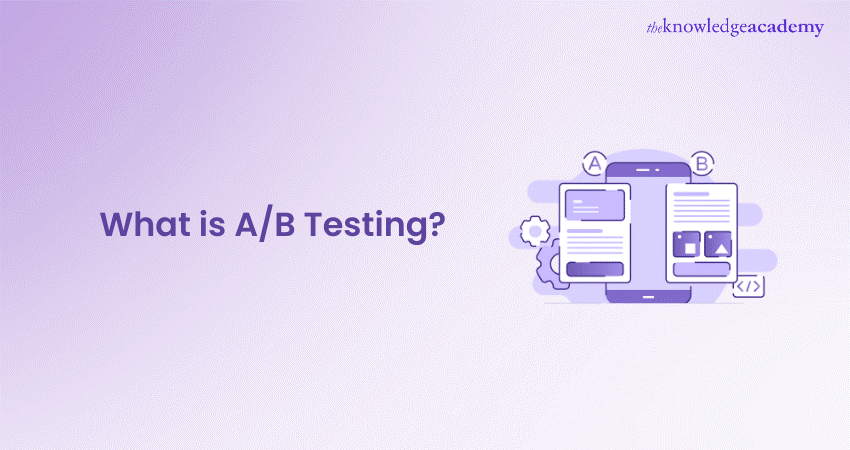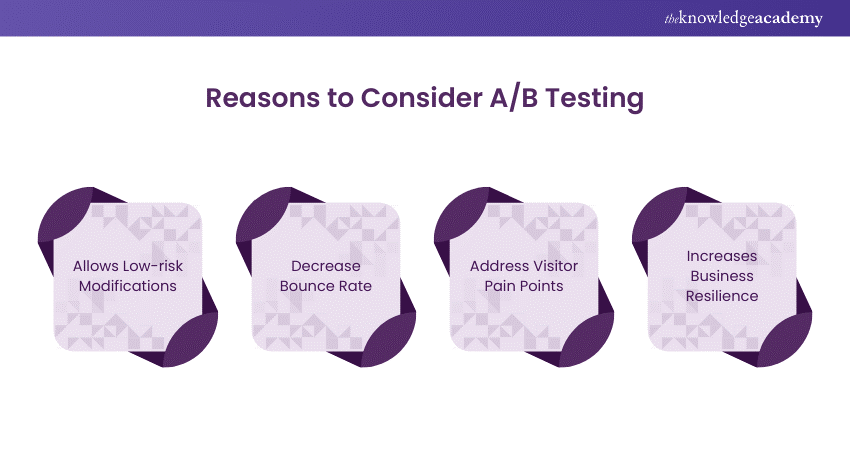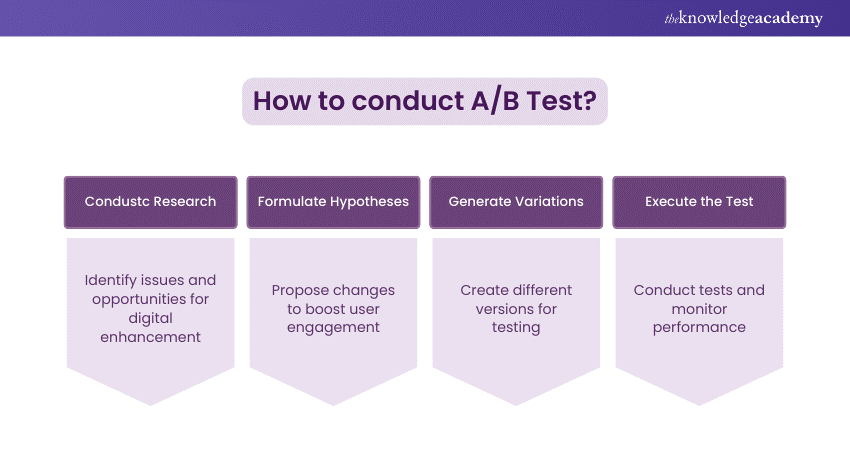We may not have the course you’re looking for. If you enquire or give us a call on +44 1344 203 999 and speak to our training experts, we may still be able to help with your training requirements.
Training Outcomes Within Your Budget!
We ensure quality, budget-alignment, and timely delivery by our expert instructors.

Have you ever poured your heart into a website or app only to see user engagement fall flat? You're not alone. Creating experiences that resonate with your audience can feel like a guessing game. But what if there was a way to scientifically test different approaches and see what truly works? Enter A/B Testing, a powerful tool that can revolutionise the way you optimise your digital products.
This blog explores the world of A/B Testing, answering the question “What is A/B Testing?” in clear detail. Further, it explores the core concepts, the testing process, and equips you with the knowledge to confidently implement A/B Testing and skyrocket your conversion rates!
Table of Contents
1) What is A/B Testing?
2) Reasons to Consider A/B Testing
3) Exploring Various Types of A/B Tests
4) Steps to Perform an A/B Test
5) The Importance of Analytics in Website A/B Testing
6) Benefits of A/B Testing
7) Overcoming Challenges in A/B Testing
8) Conclusion
What is A/B Testing?
A/B Testing involves creating two different versions (A and B) of a webpage or application element, then showing these versions to different segments of your audience at the same time. By measuring which version performs better against a predefined goal, you can make data-driven decisions to improve user experience and achieve business objectives.
In the digital realm, A/B Testing, also known as split testing, works much the same way. Picture your website as your culinary creation and each variant as a unique flavour profile. You serve up Version A to one group of visitors and Version B to another, observing their reactions like a culinary connoisseur. A/B Testing allows you to showcase both to your audience simultaneously, gauging their responses to each visual feast.
But A/B Testing isn't just about aesthetics—it's about impact. You tweak the placement of your "Shop Now" button or the wording of your product descriptions, eager to see which version entices more clicks and conversions.
Take the example of an online subscription service offering streaming content. By testing different pricing structures—perhaps one plan offers a free trial while another provides a discounted annual rate—you can gauge which option resonates best with your audience's wallets and viewing habits.
Reasons to Consider A/B Testing
Now that you have understood What A/B Testing is let us look at the various reasons why you should consider employing A/B.

1) Implement Low-risk Modifications
Think of A/B Testing as a careful first step into the world of digital changes. For example, if you own a coffee shop and are considering a new logo, A/B Testing allows you to try out small changes—like adjusting the colour or font on your website—before committing fully. This way, you can test the waters without the risk of turning away your loyal customers, getting a feel for their reactions with minimal risk.
2) Decrease Bounce Rate
Imagine your website as a vibrant marketplace. If customers come in and leave quickly without really engaging, something isn’t right. A/B Testing helps you act like a smart shopkeeper who rearranges the store to make it more inviting. By tweaking your website's layout, content, or navigation based on user behaviour, you can encourage visitors to stay longer, transforming casual browsers into committed patrons.
3) Address Visitor Pain Points
Navigating a website shouldn't be like trying to find your way out of a maze. A/B Testing helps illuminate issues that might confuse or frustrate users, such as complicated menus or broken links. By pinpointing and fixing these issues, you can smooth out the user experience, making your website a place where visitors feel understood and valued.
4) Revamp the Website for Future Business Growth
In the fast-paced digital world, staying static means falling behind. A/B Testing is like having a compass in uncharted territory, guiding you to adapt and thrive. Like a gardener who prunes plants to spur growth, this approach helps you adjust to changing consumer preferences and market trends. This ensures your business remains resilient and forward-looking in an ever-evolving landscape.
Exploring various types of A/B Tests
In this section, we will explore the various types of A/B Tests:
1) Split URL Testing
Imagine you're at a crossroads in the digital world. Split URL testing acts like your navigational tool, guiding you toward the path that leads to better user engagement and conversions. By directing users to different URLs, such as www.example.com/versionA and www.example.com/versionB, you can discover which version resonates more, gaining insights that guide you toward your digital goals.
2) Multivariate Testing (MVT)
Think of your website as a complex ecosystem where every element plays a part. Multivariate testing is like going on a safari, exploring how different elements interact and affect user behaviour. Instead of changing one thing at a time, MVT lets you change multiple elements—like headlines, images, and buttons—to see how they collectively influence the user experience. This deep dive into your site’s ecosystem can unlock valuable insights, helping you craft a more engaging digital space.
3) Multipage Testing
Consider this the "choose-your-own-adventure" book of website optimisation. With multipage testing, you’re not just tweaking a single page but exploring different narratives across multiple pages of your website. From the landing page to the checkout, each page is an opportunity to engage and delight users differently, offering them a tailored journey. This approach helps ensure that every part of your site contributes to a cohesive, engaging user experience.
Unlock the power of data with our Big Data and Analytics Courses – your gateway to mastering data-driven decision-making!
Steps to Perform an A/B Test
Let’s explore the steps to perform an A/B Test:

1) Conduct Research
Start by diving deep into your digital world. Gather user feedback, analyse data, and draw on industry best practices to uncover issues and opportunities within your digital environment. This is your chance to identify what’s not working and what could potentially attract more engagement.
2) Observe and Formulate Hypotheses
With the insights from your research, put on your detective hat and start hypothesising. Think A/Bout potential changes that could enhance user interaction and convert casual visitors into dedicated followers. Whether it’s tweaking a call-to-action button or changing a page layout, your hypotheses should aim to solve the problems identified in your research.
3) Generate Variations
Now, let your creativity flow and develop different variants of your website or app based on your hypotheses. These variations might include different visual elements, content changes, or even new navigation paths. Each version should represent a possible future scenario where user engagement improves.
4) Execute the Test
Launch your variations through a reliable A/B Testing platform, ensuring that each visitor’s experience is randomly assigned but consistent during their journey. Keep a close eye on how these tests perform—think of yourself as a conductor of an orchestra, where every instrument, i.e., the test variation, must work in harmony to produce a beautiful symphony in the form of successful outcomes.
Transform your career with our Data Science Analytics Course – dive into the world of data and emerge as an analytics expert!
The Importance of Analytics in Website A/B Testing
Analytics are like the compass in the A/B Testing maze to help show the way towards successful digital optimisation. Take this analogy—suppose you are the captain of a ship through some uncharted waters. The sextant to a captain is kind of like analytics to those leading the helm of your website or digital effort. With every scroll and click, analytics charts a course for your user behaviour through the rolling seas and can even show you hidden currents below the surface.

Now, imagine that you are an owner of an online bookstore and have two homepage variants: one that puts bestsellers to the front and one puts discounted books to the front. With analytics help, you can trace user activities on each variant and find out what makes the reader continue reading or, probably, decide to buy.
Analytics are like a compass guiding out of treacherous waters into smoother sailing. You'll know by studying metrics like bounce rates and conversion rates what variations are going to resonate most strongly with your audience and what might need a little course correction.
In the swirling e-commerce waters, analytics are not just a tool; they're your first mate, helping you chart your site to the shores of success. With analytics as your first mate, you can boldly navigate over ever-changing currents in user behaviour and sail to the shores of optimisation victory.
Benefits of A/B Testing
Here are the key benefits of A/B Testing:
1) Minimise Risks
A/B Testing acts as a safety net, allowing businesses to cautiously test new ideas without major risks. It's similar to a chef sampling a dish before serving it to guests, ensuring any potential issues are addressed before they impact the larger audience.
2) Boost Engagement
Imagine your website as a bustling market filled with eager shoppers. A/B Testing serves as a guide, helping navigate customers through a seamless and engaging journey. By optimising elements such as navigation menus and product displays, you transform passive visitors into active participants, enhancing their connection with your brand and prolonging their stay.
3) Improve Content Quality
In the digital realm, content reigns supreme, but it must evolve to meet changing audience preferences. A/B Testing acts as a trusted advisor, helping you fine-tune your content strategy to strike a chord with your audience. Whether you're tweaking headlines or experimenting with different multimedia formats, each change is a strategic move towards creating more engaging content.
4) Cut Down on Expenses
In the competitive business landscape, effective resource allocation is crucial. A/B Testing is a strategic ally that helps you spend wisely, avoiding wasteful investments in unproven strategies. This data-driven approach ensures that every quid spent is aimed at maximising returns and reducing waste, allowing your budget to stretch further.
Elevate your Excel skills to expert level with our comprehensive Data Analysis Training Using MS Excel – start analysing data like a pro today!
Overcoming challenges in A/B Testing
Here are the steps to overcoming challenges in A/B Testing:
1) Analysing Test Results Effectively
Deciphering A/B test results is no small feat—it requires a keen eye for detail akin to a detective's skill in picking out clues from a sea of noise. Think of your data as a cryptic message waiting to be decoded. By spotting patterns and anomalies, you can distinguish meaningful insights from mere background noise, paving the way for informed decision-making.
2) Nurturing a Testing-oriented Culture
Imagine a vibrant laboratory where each team member dons the white coat of curiosity and innovation. Cultivating a culture of testing is about more than just conducting experiments; it involves fostering a mindset of continuous curiosity, collaboration, and improvement. In this digital age, it's akin to turning raw data into valuable insights that drive growth and innovation, much like alchemists transforming ordinary metals into gold.
3) Selecting Suitable Test Variables
Not all variables in the vast landscape of A/B Testing are created equal. Like a skilled gardener nurturing a bountiful garden, a tester must carefully select the most promising hypotheses for experimentation. Focus on elements directly linked to desired outcomes to cultivate a garden of actionable insights that can lead to tangible improvements and significant results.
4) Crafting Hypotheses Precisely
Creating hypotheses is like drawing a detailed map for a treasure hunt, where every clue guides you closer to the prize of optimisation. Testers craft these hypotheses with precision and foresight, serving as navigational beacons that ensure each experiment aligns with broader strategic goals. Like master cartographers, they chart a clear course towards success.
5) Determining the Appropriate Sample Size
Choosing the right sample size in A/B Testing is a delicate balancing act between statistical rigour and practical constraints. It's akin to a conductor orchestrating a symphony, where the harmony of statistical power and real-world considerations must resonate perfectly. This careful balance ensures that each experiment is robust enough to provide reliable insights while being feasible to implement.
Conclusion
Empowered by your newfound understanding of What is A/B Testing, you can ditch the guesswork and refine your website or app into a conversion machine. Remember, A/B Testing is a continuous journey of experimentation and optimisation. So, keep testing, keep improving, and watch your conversion rates reach new heights!
Step into the world of Big Data with our comprehensive Big Data Analysis Course – your journey to becoming a data expert starts here!
Frequently Asked Questions

Split testing or A/B Testing works by comparing two versions of a website against each other to determine which one performs better. It involves showing two variants to users using statistical analysis to determine which is more effective.

In A/B testing, the control group is the original version (A) against which the new version (B) is tested. It serves as a benchmark to measure the changes and effectiveness of the new variant.

The Knowledge Academy takes global learning to new heights, offering over 30,000 online courses across 490+ locations in 220 countries. This expansive reach ensures accessibility and convenience for learners worldwide.
Alongside our diverse Online Course Catalogue, encompassing 17 major categories, we go the extra mile by providing a plethora of free educational Online Resources like News updates, Blogs, videos, webinars, and interview questions. Tailoring learning experiences further, professionals can maximise value with customisable Course Bundles of TKA.

The Knowledge Academy’s Knowledge Pass, a prepaid voucher, adds another layer of flexibility, allowing course bookings over a 12-month period. Join us on a journey where education knows no bounds.

The Knowledge Academy offers various Big Data and Analytics Trainings, including the Data Science Analytics Course, Data Analytics with R Course and the Big Data Analysis Course. These courses cater to different skill levels, providing comprehensive insights into Big Data Analytics.
Our Data, Analytics & AI Blogs cover a range of topics related to A/B Testing, offering valuable resources, best practices, and industry insights. Whether you are a beginner or looking to advance your Data, Analytics & AI skills, The Knowledge Academy's diverse courses and informative blogs have got you covered.







 Top Rated Course
Top Rated Course




 If you wish to make any changes to your course, please
If you wish to make any changes to your course, please


